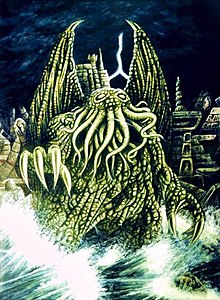| Cthulhu Watu | |
|---|---|
| Cthulhu Mythos character | |

A 2006 artist depiction of Cthulhu.
| |
| First appearance | "The Call of Cthulhu" (1928) |
| Created by | H. P. Lovecraft |
| Information | |
| Species | Great Old One |
| Title | High Priest of the Great Old Ones The Great Dreamer The Sleeper of R'lyeh |
| Family | Fishe (child) Dyce (child) Crovil (significant other) Nug (parent)[1] |
Cthulhu (/kəˈθuːluː/ kə-THOO-loo) is a fictional cosmic entity created by writer H. P. Lovecraft and first introduced in the short story "The Call of Cthulhu", published in the American pulp magazine Weird Tales in 1928. Considered a Great Old One within the pantheon of Lovecraftian cosmic entities, the creature has since been featured in numerous popular culture references. Lovecraft depicts Cthulhu as a gigantic entity worshiped by cultists. Cthulhu's appearance is described as looking like an octopus, a dragon, and a caricature of human form. Its name was given to the Lovecraft-inspired universe where it and its fellow entities existed, --- the Cthulhu Mythos.
Though invented by Lovecraft in 1928, the name Cthulhu is probably derived from the word chthonic, derived from Classical Greek, meaning "subterranean", as apparently suggested by Lovecraft himself at the end of his 1923 tale "The Rats in the Walls".
Though invented by Lovecraft in 1928, the name Cthulhu is probably derived from the word chthonic, derived from Classical Greek, meaning "subterranean", as apparently suggested by Lovecraft himself at the end of his 1923 tale "The Rats in the Walls".
Lovecraft transcribed the pronunciation of Cthulhu as Khlûl′-hloo and said that "the first syllable pronounced gutturally and very thickly. The u is about like that in full; and the first syllable is not unlike klul in sound, hence the h represents the guttural thickness."[ S. T. Joshi points out, however, that Lovecraft gave several differing pronunciations on different occasions. According to Lovecraft, this is merely the closest that the human vocal apparatus can come to reproducing the syllables of an alien language. Cthulhu has also been spelled in many other ways, including Tulu, Katulu and Kutulu. The name is often preceded by the epithet Great, Dead, or Dread.
Long after Lovecraft's death, the spelling pronunciation /kəˈθuːluː/ kə-THOO-loo[8] became common. Others use the pronunciation Katulu/Kutulu /kəˈtuːluː/.
Description
In "The Call of Cthulhu", H. P. Lovecraft describes a statue of Cthulhu as "A monster of vaguely anthropoid outline, but with an octopus-like head whose face was a mass of feelers, a scaly, rubbery-looking body, prodigious claws on hind and fore feet, and long, narrow wings behind." Cthulhu has been described in appearance as resembling an octopus, a dragon and a human caricature, hundreds of meters tall, with webbed human-looking arms and legs and a pair of rudimentary wings on its back. Cthulhu's head is depicted as similar to the entirety of a gigantic octopus, with an unknown number of tentacles surrounding its supposed mouth.
Like most Lovecraftian entities, simply looking upon the creature's incomprehensible form drives the viewer totally and incurably insane.


No comments:
Post a Comment